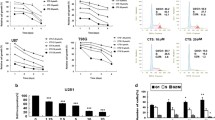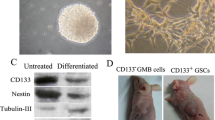Abstract
Malignant gliomas (MGs) are among the most aggressive types of cancers in the human brain. Frequent tumor recurrence caused by a lack of effective therapeutic approaches results in a poor prognosis. Signal transducer and activator of transcription 3 (STAT3), an oncogenic protein, is constitutively activated in MGs and predicts a poor clinical outcome. STAT3 therefore is considered to be a promising target for the treatment of MGs. Cryptotanshinone (CTS), the main bioactive compound from the root of Salvia miltiorrhiza Bunge, has been reported to have various pharmacological effects. However, little is known about its function in MG cells. In this study, we evaluated the effect of CTS on the proliferation of human glioma cell lines (T98G and U87). Our results revealed that CTS significantly suppresses glioma cell proliferation. The phosphorylation of STAT3 Tyr705, but not Ser727, was inhibited by CTS, and STAT3 nuclear translocation was attenuated. Overexpression of constitutively active mutant STAT3C reversed the inhibitory effect of CTS, while knockdown STAT3 showed a similar inhibitory effect as CTS treatment. Following the downregulation of STAT3-regulated proteins cyclinD1 and survivin, cell cycle progression significantly arrested in G1/G0 phase. These results indicate that CTS may be a potential antiproliferation agent for the treatment of MGs and that its mechanism may be related to the inhibition of STAT3 signaling.





Similar content being viewed by others
References
Ohgaki H, Kleihues P (2005) Population-based studies on incidence, survival rates, and genetic alterations in astrocytic and oligodendroglial gliomas. J Neuropathol Exp Neurol 64:479–489
Dolecek TA, Propp JM, Stroup NE, Kruchko C (2012) CBTRUS statistical report: primary brain and central nervous system tumors diagnosed in the United States in 2005–2009. Neuro Oncol 14:v1–v49
Stupp R, Mason WP, van den Bent MJ et al (2005) Radiotherapy plus concomitant and adjuvant temozolomide for glioblastoma. N Engl J Med 352:987–996
Deorah S, Lynch CF, Sibenaller ZA, Ryken TC (2006) Trends in brain cancer incidence and survival in the United States: surveillance, epidemiology, and end results program, 1973–2001. Neurosurg Focus 20:E1
Lo HW (2010) Targeting Ras-RAF-ERK and its interactive pathways as a novel therapy for malignant gliomas. Curr Cancer Drug Targets 10:840–848
Herbert B Newton (2004) Molecular neuro-oncology and development of targeted therapeutic strategies for brain tumors. Part 2: pI3K/Akt/PTEN, mTOR. SHH/PTCH and angiogenesis 4:105–128
Stechishin OD, Luchman HA, Ruan Y et al (2013) On-target JAK2/STAT3 inhibition slows disease progression in orthotopic xenografts of human glioblastoma brain tumor stem cells. Neuro Oncol 15:198–207
Doucette TA, Kong LY, Yang Y et al (2012) Signal transducer and activator of transcription 3 promotes angiogenesis and drives malignant progression in glioma. Neuro Oncol 14:1136–1145
Heimberger AB, Priebe W (2008) Small molecular inhibitors of p-STAT3: novel agents for treatment of primary and metastatic CNS cancers. Recent Pat CNS Drug Discov 3:179–188
Carro MS, Lim WK, Alvarez MJ et al (2010) The transcriptional network for mesenchymal transformation of brain tumours. Nature 463:318–325
Huang S (2007) Regulation of metastases by signal transducer and activator of transcription 3 signaling pathway: clinical implications. Cancer Res 13:1362–1366
Heimberger AB (2011) The therapeutic potential of inhibitors of the signal transducer and activator of transcription 3 for central nervous system malignancies. Surg Neurol Int 2:163
Ang KP, Tan HK, Selvaraja M et al (2011) Cryptotanshinone attenuates in vitro oxLDL-induced pre-lesional atherosclerotic events. Planta Med 77:1782–1787
Jin YC, Kim CW, Kim YM et al (2009) Cryptotanshinone, a lipophilic compound of Salvia miltiorrhiza root, inhibits TNF-alpha-induced expression of adhesion molecules in HUVEC and attenuates rat myocardial ischemia/reperfusion injury in vivo. Eur J Pharmacol 614:91–97
Tang S, Shen XY, Huang HQ et al (2011) Cryptotanshinone suppressed inflammatory cytokines secretion in RAW264.7 macrophages through inhibition of the NF-kappaB and MAPK signaling pathways. Inflammation 34:111–118
Mei Z, Zhang F, Tao L et al (2009) Cryptotanshinone, a compound from Salvia miltiorrhiza modulates amyloid precursor protein metabolism and attenuates beta-amyloid deposition through upregulating alpha-secretase in vivo and in vitro. Neurosci Lett 452:90–95
Park IJ, Kim MJ, Park OJ et al (2012) Cryptotanshinone induces ER stress-mediated apoptosis in HepG2 and MCF7 cells. Apoptosis 17:248–257
Gong Y, Li Y, Lu Y et al (2011) Bioactive tanshinones in Salvia miltiorrhiza inhibit the growth of prostate cancer cells in vitro and in mice. Int J Cancer 129:1042–1052
Li H, Zhang Q, Chu T et al (2012) Growth-inhibitory and apoptosis-inducing effects of tanshinones on hematological malignancy cells and their structure-activity relationship. Anticancer Drugs 23:846–855
Ye Y, Xu W, Zhong W (2010) Effects of cryptotanshinone on proliferation and apoptosis of Hela cell line of cervical cancer. Zhongguo Zhong Yao Za Zhi 35:118–121
Shin DS, Kim HN, Shin KD (2009) Cryptotanshinone inhibits constitutive signal transducer and activator of transcription 3 function through blocking the dimerization in DU145 prostate cancer cells. Cancer Res 69:193–202
Chen W, Luo Y, Liu L et al (2010) Cryptotanshinone inhibits cancer cell proliferation by suppressing Mammalian target of rapamycin-mediated cyclin D1 expression and Rb phosphorylation. Cancer Prev Res (Phila) 3:1015–1025
Bromberg JF, Wrzeszczynska MH, Devgan G et al (1999) Stat3 as an oncogene. Cell 98:295–303
Hillion J, Dhara S, Sumter TF et al (2008) The high-mobility group A1a/signal transducer and activator of transcription-3 axis: an achilles heel for hematopoietic malignancies? Cancer Res 68:10121–10127
Weissenberger J, Priester M, Bernreuther C et al (2010) Dietary curcumin attenuates glioma growth in a syngeneic mouse model by inhibition of the JAK1,2/STAT3 signaling pathway. Clin Cancer Res 16:5781–5795
Pan Y, Bi HC, Zhong GP et al (2008) Pharmacokinetic characterization of hydroxylpropyl-beta-cyclodextrin-included complex of cryptotanshinone, an investigational cardiovascular drug purified from Danshen (Salvia miltiorrhiza). Xenobiotica 38:382–398
Zhou J, Wulfkuhle J, Zhang H et al (2007) Activation of the PTEN/mTOR/STAT3 pathway in breast cancer stem-like cells is required for viability and maintenance. Proc Natl Acad Sci USA 104:16158–16163
Rane SG, Reddy EP (2000) Janus kinases: components of multiple signaling pathways. Oncogene 19:5662–5679
Don MJ, Liao JF, Lin LY, Chiou WF (2007) Cryptotanshinone inhibits chemotactic migration in macrophages through negative regulation of the PI3K signaling pathway. Br J Pharmacol 151:638–646
Cavalla P, Dutto A, Piva R et al (1998) Cyclin D1 expression in gliomas. Acta Neuropathol 95:131–135
Yamada Y, Kuroiwa T, Nakagawa T et al (2003) Transcriptional expression of survivin and its splice variants in brain tumors in humans. J Neurosurg 99:738–745
Stacey DW (2003) Cyclin D1 serves as a cell cycle regulatory switch in actively proliferating cells. Curr Opin Cell Biol 15:158–163
Suzuki A, Hayashida M, Ito T et al (2000) Survivin initiates cell cycle entry by the competitive interaction with Cdk4/p16 (INK4a) and Cdk2/cyclin E complex activation. Oncogene 19:3225–3234
Acknowledgments
This study was supported by the National Natural Science Foundation of China (No. 31070924 and 81173056), Projects of International Cooperation and Exchanges, Science and Technology Planning Project of Guangdong Province, China (No. 1011420600004), and the Research Fund for the Doctoral Program of Higher Education of China (No. 20100171110052).
Author information
Authors and Affiliations
Corresponding author
Rights and permissions
About this article
Cite this article
Lu, L., Li, C., Li, D. et al. Cryptotanshinone inhibits human glioma cell proliferation by suppressing STAT3 signaling. Mol Cell Biochem 381, 273–282 (2013). https://doi.org/10.1007/s11010-013-1711-x
Received:
Accepted:
Published:
Issue Date:
DOI: https://doi.org/10.1007/s11010-013-1711-x




